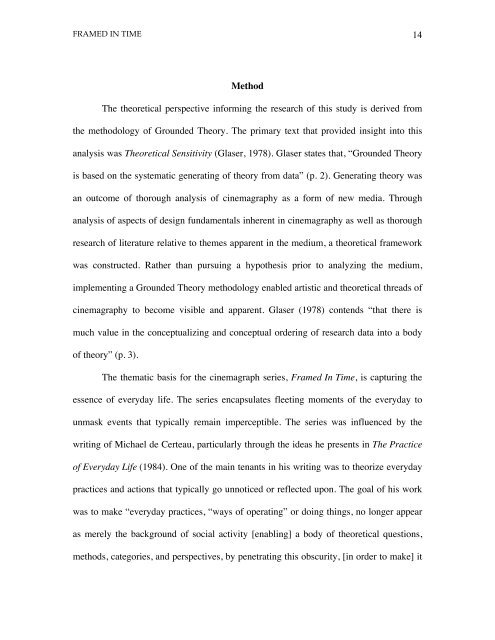FRAMED IN TIME: A CINEMAGRAPH SERIES OF ... - Niewland Media
FRAMED IN TIME: A CINEMAGRAPH SERIES OF ... - Niewland Media
FRAMED IN TIME: A CINEMAGRAPH SERIES OF ... - Niewland Media
You also want an ePaper? Increase the reach of your titles
YUMPU automatically turns print PDFs into web optimized ePapers that Google loves.
<strong>FRAMED</strong> <strong>IN</strong> <strong>TIME</strong><br />
Method<br />
The theoretical perspective informing the research of this study is derived from<br />
the methodology of Grounded Theory. The primary text that provided insight into this<br />
analysis was Theoretical Sensitivity (Glaser, 1978). Glaser states that, “Grounded Theory<br />
is based on the systematic generating of theory from data” (p. 2). Generating theory was<br />
an outcome of thorough analysis of cinemagraphy as a form of new media. Through<br />
analysis of aspects of design fundamentals inherent in cinemagraphy as well as thorough<br />
research of literature relative to themes apparent in the medium, a theoretical framework<br />
was constructed. Rather than pursuing a hypothesis prior to analyzing the medium,<br />
implementing a Grounded Theory methodology enabled artistic and theoretical threads of<br />
cinemagraphy to become visible and apparent. Glaser (1978) contends “that there is<br />
much value in the conceptualizing and conceptual ordering of research data into a body<br />
of theory” (p. 3).<br />
The thematic basis for the cinemagraph series, Framed In Time, is capturing the<br />
essence of everyday life. The series encapsulates fleeting moments of the everyday to<br />
unmask events that typically remain imperceptible. The series was influenced by the<br />
writing of Michael de Certeau, particularly through the ideas he presents in The Practice<br />
of Everyday Life (1984). One of the main tenants in his writing was to theorize everyday<br />
practices and actions that typically go unnoticed or reflected upon. The goal of his work<br />
was to make “everyday practices, “ways of operating” or doing things, no longer appear<br />
as merely the background of social activity [enabling] a body of theoretical questions,<br />
methods, categories, and perspectives, by penetrating this obscurity, [in order to make] it<br />
14


